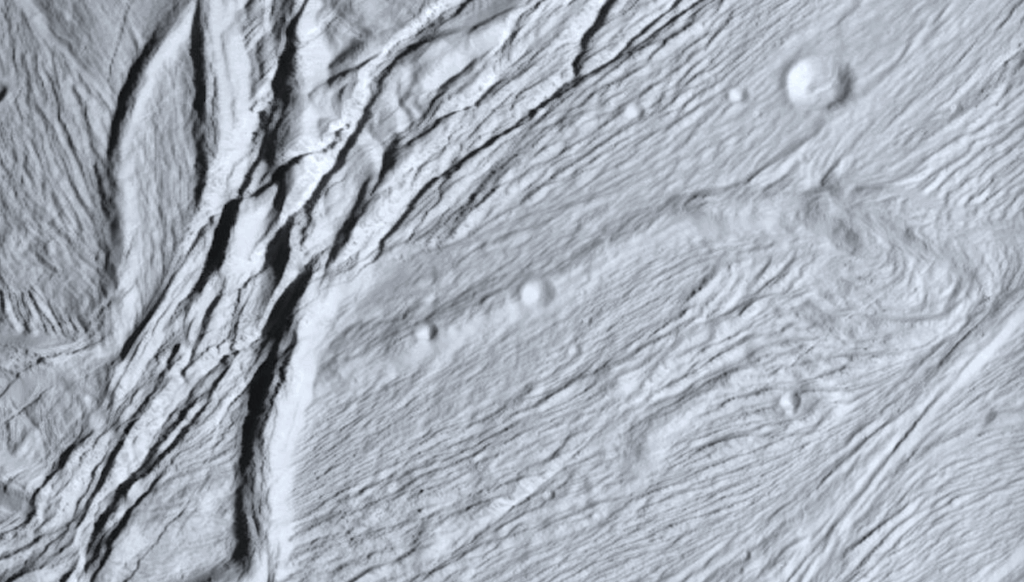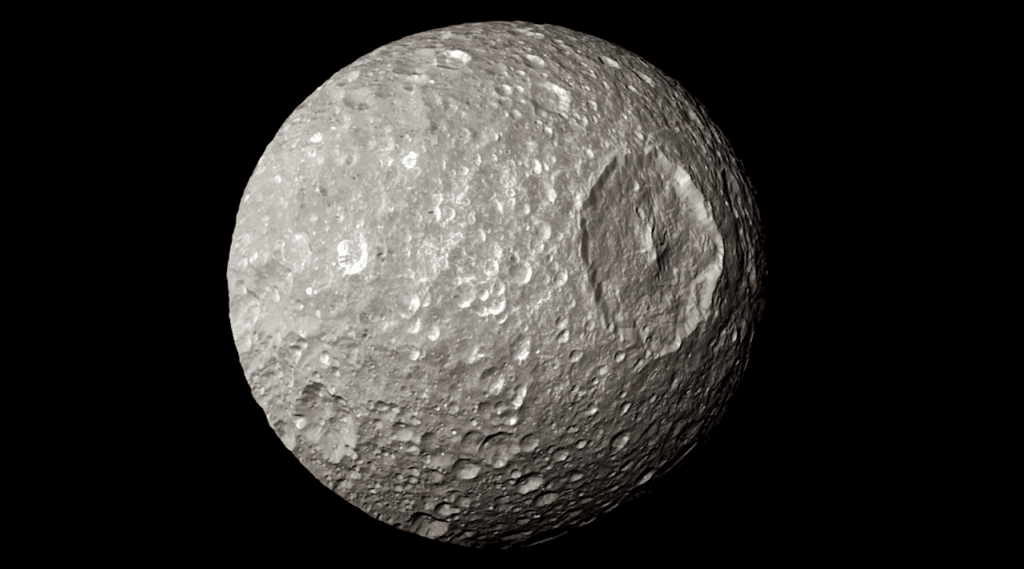Hydrothermal Activity in The Seas of Enceladus: Implications For Habitable Zones

On Thursday NASA will announce evidence that hydrothermal activity on the floor of an ice-covered ocean on Saturn’s moon Enceladus is most likely creating methane from carbon dioxide. The process is indicative of possible habitable zones within the ocean of Enceladus.
But before we go any further, “habitable” does not mean “inhabited”.
NASA bases this determination on the amount of hydrogen in plumes emanating from the moon’s south pole. The large amount of hydrogen is strongly suggestive of a constant hydrothermal process wherein the ocean under the surface of Enceladus is interacting with rock and organic compounds. The amount of hydrogen present is in disequilibrium i.e. if there was not a process that was constantly generating hydrogen the observed hydrogen levels would likely be lower than what is seen. Something is pumping it out.
Saturn’s moon Enceladus is known to have an ocean beneath its icy surface. This small moon constantly sprays its ocean’s contents into space from vents at its south pole from a region referred to as the “tiger stripes” due to the appearance of the location. The Cassini spacecraft has actually flown through these plumes many times and sampled their composition. Based on these plume studies it has been previously determined that the ocean of Enceladus interacts with a rocky bottom.
During the final – and closest (30 miles/49 km) – flyby by Cassini of Enceladus on 28 October 2015 (E21) the spacecraft’s Ion and Neutral Mass Spectrometer (INMS) was configured so as to best understand the amount of hydrogen in the plumes. A significant amount was found. Something is creating this hydrogen. The precise mechanism of this process is not known but hydrothermal activity is highly suspected. (Cassini Orbiter Ion and Neutral Mass Spectrometer (INMS) level 1A high and the low sensitivity counter data archive)
Hydrothermal vents have been found in many locations on Earth where superheated water from deep within the planet reaches the ocean. Due to the temperatures and pressure of these vents, some very interesting chemistry occurs. Many astrobiologists have suggested that such hydrothermal vents may be where life first originated on our planet. Fossil evidence of hydrothermal vents lends credence to this theory.
Interestingly, just as there are many mechanisms that could be operating on Enceladus that involve geochemistry (i.e. no life) there are some possible mechanisms that could be suggestive of biological processes. There are forms of life on Earth that use hydrogen to produce methane from and carbon dioxide in a process known as methanogenesis [CO2 + 4H2 -> CH4 + 2H20]. As such, if similar conditions exist on Enceladus, the issue of habitability arises. But again, this could just be chemistry that happens without any living processes involved.
On our planet these hydrothermal vents often host complex ecologies with some microorganisms deriving energy directly from the mineralogical chemistry surrounding these vents instead of obtaining energy from the sun. In turn, larger life forms feed upon these microorganisms and entire communities can arise. Unlike the ecological interactions we are used to seeing on Earth’s surface where life either depends directly on sunlight or eats life forms that depend on sunlight, these deep hydrothermal communities are able to operate without any energy input from the sun. There are also hydrothermal systems that operate near to – or at – the surface of Earth that also host forms of life that rely on chemistry instead of sunlight as an energy source.
Life in Earth can thrive in exceptionally hot, caustic, and remote locations that we’d never consider to habitable. We call such forms of life “extremeophiles“. But to these life forms, its not extreme at all. Its normal.

So – is there some sort of unique mineral chemistry at work on Enceladus at hydrothermal vents or is there a biological process involved? Or both? This research from the Cassini team really does not directly answer that question. But something is clearly going on in the depths of the seas of Enceladus. NASA has not found life on Enceladus. Nor has NASA found indirect evidence of life on Enceladus.
What Cassini may have found is evidence that there may be locations on Enceladus that are similar to places on Earth where life is known to exist. All that has been found are possible similarities.
That said, the ramifications extend far beyond Enceladus, however. Another moon of Saturn. Saturn’s moon Mimas may also have a subsurface ocean while Titan has hydrocarbon lakes on its surface and possibly a salty brine ocean underneath. There is a lot of interest in Jupiter’s moon Europa which is also known to have a subsurface ocean and vents plumes into space. There is also evidence that nearby jovian moons Ganymede and Callisto may also have subsurface oceans. Neptune’s moon Triton and dwarf planets Ceres and Pluto may all have oceans as well.
Again – “habitable” does not mean “inhabited”. But the more worlds we find that are potentially habitable, the greater the chances are that we may find worlds that actually are inhabited. Given that the number of icy worlds within our solar system with known or suspected subsurface oceans continues to increase, one would think that the odds are getting better all the time.
Press conference:
NASA will hold a press briefing on 13 April 2017 at 2:00 pm EDT in Washington, DC. The schedule briefing participants announced are:
– Thomas Zurbuchen, associate administrator, Science Mission Directorate at NASA Headquarters in Washington
– Jim Green, director, Planetary Science Division at NASA Headquarters
– Mary Voytek, astrobiology senior scientist at NASA Headquarters
– Linda Spilker, Cassini project scientist at NASA’s Jet Propulsion Laboratory in Pasadena, California
– Hunter Waite, Cassini Ion and Neutral Mass Spectrometer (INMS) team lead at the Southwest Research Institute (SwRI) in San Antonio
– Chris Glein, Cassini INMS team associate at SwRI
– William Sparks, astronomer with the Space Telescope Science Institute in Baltimore
Additional Information (added 13 April 2017)
– Cassini finds molecular hydrogen in the Enceladus plume: Evidence for hydrothermal processes, Science
– New Insights into Ocean Worlds Enceladus and Europa, NASA
References:
– Evidence for early life in Earth’s oldest hydrothermal vent precipitates
– Sustained eruptions on Enceladus explained by turbulent dissipation in tiger stripes, astro-ph.EP
– THEO Concept Mission: Testing the Habitability of Enceladus’s Ocean, astro-ph.EP
– Aggregate Particles in the Plumes of Enceladus, astro-ph.EP
– The pH of Enceladus’ ocean, astro-ph.EP
– Enceladus Flyby 21 (E-21): Deepest Dive Through the Plume, NASA
“1. Confirm presence of molecular hydrogen (H2)
– This measurement will be accomplished using Cassini’s sensor that sniffs the gases in the plume (called INMS)
– Confirmation of H2 would be an independent line of evidence that hydrothermal activity is taking place in the Enceladus ocean, on the seafloor
– Amount of H2 Cassini measures would reveal how much hydrothermal activity is going on in the ocean.
– This has implications for the amount of energy available for creating a habitable environment in the ocean”








